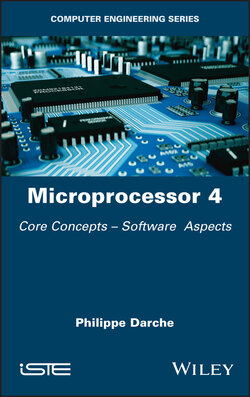Читать книгу Microprocessor 4 - Philippe Darche - Страница 24
1.2.3.3. Indirect addressing
ОглавлениеIt is useful to dissociate addressing of the operand from that of the instruction code. The address may thus vary without changing the reference indicated in the instruction. This mode is used to implement the mechanism of the High-Level (programming) Language (HLL) pointer. In assembly language, the square brackets “[“ and “]” are generally used to employ this mode. Some constructors use parentheses or the character @. A memory location or register contains the address of the operand. In indirect mode or register deferred mode (register indirect or register deferred addressing7) illustrated in Figure 1.14, the effective address EA is given by the following formula:
[1.3]
Figure 1.14. Instruction with indirect register addressing
In memory indirect addressing illustrated in Figure 1.15, the final effective address EA is given by formula [1.5]. Here, it is a double indirection:
[1.4]
[1.5]
Figure 1.15. Instruction with indirect memory addressing
This mode of addressing generally has a greater extent than direct addressing since the addressing format m is the same as that of the data format n. It was therefore useful for the first computers, which had a restricted addressing capacity (in the case of mini-PDP-8 computers from the DEC firm of the NOVA series from Data General, for example). Another advantage is the decrease in the instruction format, thus increasing the instruction throughput. For MC6809, the constructor speaks of “extended indirect addressing”. The compiler will doubtlessly use this mode to implement the high-level language pointer mode such as C or Pascal by putting the value of the pointer (i.e. an address) in the indirection register.
An auto-increment or auto-decrement can be suggested, which can be done before (prefix “pre”) or after (prefix “post”) the instruction using it is executed. It makes it possible to implement operators directly, such as ++ and -- in the language C. This means that after execution of this operator, the value of the pointer that contains the address of the object pointed to is incremented or decremented by a value equal to the size of the pointed element. But in the MPU, the increment or decrement value is fixed at programming in low-level language. More generally, auto-increment or auto-decrement makes it possible to manage a memory index, which is useful, for example, in displacement in a data structure such as an array. Register indirect addressing with post- or pre-increment/decrement is adapted for digital signal processing to address samples.
This mode is in fact the one that makes it possible to implement absolute addressing mode using the PC (Program Counter) as an indirection register. It is for this reason that DEC (1983) with PDP series, which used the PC as a General-Purpose Register (GPR, cf. § V3-3.1), called it “PC absolute mode”, equivalent to an immediate indirect addressing (immediate8 deferred mode or auto-increment deferred mode). The term “immediate” means that the value immediately following the instruction code addressed by the PC will be used to fetch the address of the operand (EA = PC + 2 bytes in the case of the PDP-11 mini-computer) with, afterwards, an update to the PC. This same manufacturer proposed a relative deferred mode PC addressing, that is, indirect relative addressing, which uses the PC added to a displacement to fetch the operand's address (EA = (PCinstruction + 1 + displacement) in the case of PDP-11).
